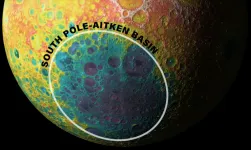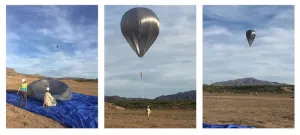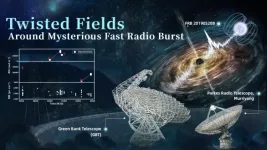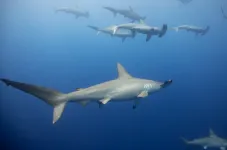(Press-News.org) Key takeaways
Stem cells travel along a collagen network to reach damaged muscle tissue and heal it.
In Duchenne muscular dystrophy, stiff, scarred collagen prevents stem cells from reaching their target.
A protein called sarcospan lessens this scarring and allows stem cells to do their job more successfully, pointing toward potential new treatments for the disorder.
Muscles that ache after a hard workout usually don’t hurt for long, thanks to stem cells that rush to the injured site along “collagen highways” within the muscle and repair the damaged tissue. But if the cells can’t reach their destination, the damaged tissue can’t regenerate. Over time, it breaks down completely and ceases to function.
In a study recently published in npj Regenerative Medicine, a group of researchers led by biochemists at UCLA show for the first time that scarring to the collagen framework that carries these healing cells causes muscles to gradually stop working in Duchenne muscular dystrophy. The discovery in mice illuminates one reason stem cell therapy has not been effective for the disorder: The cells simply can’t get where they’re needed most.
Duchenne muscular dystrophy is the most common — and one of the most severe — hereditary muscular dystrophies. The muscle-wasting disease, which usually affects boys, begins in childhood and inevitably ends in death as the muscles that power the heart, lungs and other vital organs fail. It is caused by a mutation in the gene for the dystrophin protein, which regulates the organization of muscle cells. In healthy people, dystrophin helps bundles of muscle cells called myofibers attach to the collagen framework — the extracellular matrix that gives muscles their shape, holds them together and provides the “highway” for stem cells to repair and regenerate damaged tissue.
Rachelle Crosbie, a UCLA professor of integrative biology and physiology who is looking for ways to treat Duchenne muscular dystrophy, suspected that the dysfunction caused by this mutation led to scarring and stiffening of the extracellular matrix, a process known as fibrosis.
Crosbie and Kristen Stearns-Reider, a postdoctoral fellow in Crosbie’s laboratory, designed a unique experiment to find out. Using facilities at UCLA’s California NanoSystems Institute, they devised a process to “wash” all the cells off the collagen extracellular matrix in healthy mice and those with Duchenne muscular dystrophy.
Under a microscope, the two cell-free matrices, which Crosbie calls “myoscaffolds,” appeared very different: The healthy one looked like delicate lace, while the Duchenne one looked more like a dense sponge.
Next, the researchers seeded each myoscaffold with stem cells and watched as the cells tried to grow muscle tissue. Muscle stem cells grew on the myoscaffolds exactly as they would in healthy and diseased muscle: In the healthy, lacy myoscaffold, cells migrated along the smooth threads and deposited themselves in evenly spaced holes. However, the bumpy, thickened surfaces of the Duchenne myoscaffold made travel difficult and threw up roadblocks that caused the cells to pile up in clumps; the cells were stressed an unable to progress efficiently.
“Like suburban commuters, resident stem cells live on outskirts of the muscle fiber and travel along the muscle fiber to damaged areas and regenerate muscle. The extracellular matrix is the highway they use.” Crosbie said. “It’s like the difference between driving to work on a regular day versus the day a landslide fell on the freeway.”
This is the first time scientists have imaged living cells in a fibrotic myoscaffold, revealing specifically how fibrosis disrupts cell behavior, Crosbie said.
The thin, supple threads of the healthy scaffold also yielded slightly as stem cells attached to them, a deformation critical to the successful development of muscle tissue. The stem cells were unable to deform the thick, stiff fibers of the Duchenne scaffold. Tissue grown on the Duchenne scaffold showed large clumps of myofibers interspersed with even larger clumps of collagen instead of the evenly distributed myofibers seen in the healthy sample.
Protein sarcospan offers a potential way forward
The research team then tested cell behavior on a Duchenne myoscaffold that was created using a therapeutic protein called sarcospan, which is known to stabilize the extracellular matrix. Stem cell function improved once sarcospan had minimized the formation of fibrotic scars.
“The results made it really clear why stem cell therapies have proven challenging for Duchenne muscular dystrophy,” Crosbie said. “Finding ways to prevent or reduce scarring on the extracellular matrix could make them more effective.”
These myoscaffolds offer several broad possibilities for studying stem cell–extracellular matrix interactions, stem cell niche formation, the microenvironments that influence stem cell behavior, muscle maturation and disease modeling, said study co-authors Michael Hicks, a UCLA postdoctoral fellow, and April Pyle, a UCLA professor of microbiology, immunology, and molecular genetics.
Crosbie also noted that because the new method requires only very small samples, these studies could potentially be extended to include individual patients, using tissue from a muscle biopsy to study treatments before they are administered and identifying ones more likely to be effective.
END
When stem cells can’t roll on a bumpy road, muscles break down
Study in mice shows scarring of collagen ‘highway’ prevents stem cells from healing damaged tissue in Duchenne muscular dystrophy
2023-05-11
ELSE PRESS RELEASES FROM THIS DATE:
SwRI to lead NASA/SSERVI Center for Lunar Origin and Evolution
2023-05-11
SAN ANTONIO — May 11, 2023 —Southwest Research Institute has entered into a five-year, $7.5-million cooperative agreement with NASA to lead the Center for Lunar Origin and Evolution (CLOE), which will conduct basic research to support science enabled by human exploration of the Moon and the Endurance-A mission concept, a far side lunar rover mission prioritized by the 2022 Planetary Science and Astrobiology Decadal Survey report, “Origins, Worlds, and Life.” CLOE will be part of NASA’s Solar System Exploration Research Virtual Institute (SSERVI).
“The Moon is unmatched in its potential to provide ...
Google Quantum AI braids non-Abelian anyons for the first time
2023-05-11
Our intuition tells us that it should be impossible to see whether two identical objects have been swapped back and forth, and for all particles observed to date, that has been the case. Until now.
Non-Abelian anyons - the only particles that have been predicted to break this rule - have been sought for their fascinating features and their potential to revolutionize quantum computing by making the operations more robust to noise. Microsoft and others have chosen this approach for their quantum computing effort. But after decades of efforts by researchers in the field, observing non-Abelian anyons and their strange behavior has proven challenging, ...
Solar-powered balloons detect mysterious sounds in the stratosphere #ASA184
2023-05-11
CHICAGO, May 11, 2023 – Imagine if sending your science experiment 70,000 ft in the air just took painter’s plastic, tape, a dash of charcoal dust, and plenty of sunlight.
Daniel Bowman of Sandia National Laboratories will present his findings using solar-powered hot air balloons to eavesdrop on stratospheric sounds at the upcoming 184th Meeting of the Acoustical Society of America, running May 8-12 at the Chicago Marriott Downtown Magnificent Mile Hotel. His presentation will take place Thursday, May 11, at 2:50 p.m. Eastern U.S. in the Purdue/Wisconsin ...
Earth system modeling and fossil data reveal Homo adaptation to diverse environments
2023-05-11
Homo species – particularly Homo sapiens – were uniquely equipped to adapt to highly diverse environmental conditions and landscape mosaics, according to a new study, which may have enabled our species and that of our closely related ancestors to survive and thrive in highly fluctuating Pleistocene environments. Homo sapiens are the only surviving hominin species today. However, whether this is because our species was uniquely successful at adapting to Pleistocene environments, because we outcompeted other contemporary Homo species through unique physiological or social adaptations, ...
A better route to benzocyclobutenes, sought-after buildingblocks for drugs
2023-05-11
LA JOLLA, CA— Scripps Research chemists have solved a long-standing problem in the field of pharmaceutical chemistry with a relatively simple and controllable method for making benzocyclobutenes (BCBs)—a class of reactive compounds that are highly valued as building blocks for drug molecules, but have been relatively hard to access.
The new method, described in a paper in Science on May 12, uses designer ligand molecules with palladium-atom catalysts to break pairs of adjacent methylene-type C-H bonds in relatively cheap and abundant carboxylic acids. Breaking these bonds enables the making ...
Researchers discover twisted fields around mysterious fast radio burst
2023-05-11
Fast Radio Bursts (FRBs) are the brightest millisecond-duration cosmic explosions in radio bands. Their unknown origin poses challenges for astronomy as well as physics.
The Commensal Radio Astronomy FAST Survey (CRAFTS), a key program of the Five-hundred-meter Spherical radio Telescope (FAST), discovered the world's first persistently active repeating FRB, known as FRB 20190520B. Now this FRB has provided clues that may help clarify the origin of FRBs.
An international team led by Dr. LI Di from the National Astronomical Observatories of the Chinese Academy of Sciences (NAOC) carried out a monitoring campaign of FRB 20190520B, using the Parkes telescope in Australia and ...
U.S. Fishing Policy is Boosting Fish Populations, Not Constraining Most Fisheries
2023-05-11
Commercial fishing employs 1.2 million Americans and generates more than $165 billion annually. Yet warming waters are threatening fish populations and disrupting fisheries around the world—a challenge set to worsen as climate change advances. Despite the importance of sustaining fisheries, the reauthorization of the cornerstone policy protecting them in the United States—the Magnuson-Stevens Act—has been stalled in Congress for a decade. The holdup? Some blame the policy for being too stringent and leading to what they call “underfishing,” while others ...
Human ancestors preferred mosaic landscapes and high ecosystem diversity
2023-05-11
A new study published in the journal Science by an international team finds that early human species adapted to mosaic landscapes and diverse food resources, which would have increased our ancestor’s resilience to past shifts in climate.
Our genus Homo evolved over the past 3 million years – a period of increasing warm/cold climate fluctuations. How early human species have adapted to the intensification of climate extremes, ice ages, and large-scale shifts in landscapes and vegetation remains elusive. ...
Hammerhead sharks hold their breath on deep water hunts to stay warm
2023-05-11
Scalloped hammerhead sharks hold their breath to keep their bodies warm during deep dives into cold water where they hunt prey such as deep sea squids. This discovery, published today in Science by University of Hawai‘i at Mānoa researchers, provides important new insights into the physiology and ecology of a species that serves as an important link between the deep and shallow water habitats.
“This was a complete surprise!” said Mark Royer, lead author and researcher with the Shark Research Group at the Hawai‘i Institute of Marine Biology (HIMB) in the UH Mānoa School of ...
The feeling of hunger itself may slow aging in flies
2023-05-11
From low-carb to intermittent fasting, surgery to Ozempic—people turn to a seemingly never-ending array of diets, procedures and drugs to lose weight. While it has been long understood that limiting the amount of food eaten can promote healthy aging in a wide range of animals, including humans, a new study from University of Michigan has revealed that the feeling of hunger itself may be enough to slow aging.
Previous research has demonstrated that even the taste and smell of food can reverse the beneficial, life-extending effects of diet restriction, even without its consumption.
These intriguing findings drove first author Kristy Weaver, Ph.D., principal investigator ...
LAST 30 PRESS RELEASES:
Switching immune cells to “night mode” could limit damage after a heart attack, study suggests
URI-based Global RIghts Project report spotlights continued troubling trends in worldwide inhumane treatment
Neutrophils are less aggressive at night, explaining why nighttime heart attacks cause less damage than daytime events
Menopausal hormone therapy may not pose breast cancer risk for women with BRCA mutations
Mobile health tool may improve quality of life for adolescent and young adult breast cancer survivors
Acupuncture may help improve perceived breast cancer-related cognitive difficulties over usual care
Nerve block may reduce opioid use in infants undergoing cleft palate surgery
CRISPR primes goldenberry for fruit bowl fame
Mass General Brigham announces new AI company to accelerate clinical trial screening and patient recruitment
Fat tissue around the heart may contribute to greater heart injury after a heart attack
Jeonbuk National University researcher proposes a proposing a two-stage decision-making framework of lithium governance in Latin America
Chromatin accessibility maps reveal how stem cells drive myelodysplastic progression
Cartilaginous cells regulate growth and blood vessel formation in bones
Plant hormone allows lifelong control of proteins in living animal for first time
Swedish freshwater bacteria give new insights into bacterial evolution
Global measures consistently underestimate food insecurity; one in five who suffer from hunger may go uncounted
Hidden patterns of isolation and segregation found in all American cities
FDA drug trials exclude a widening slice of Americans
Sea reptile’s tooth shows that mosasaurs could live in freshwater
Pure bred: New stem cell medium only has canine components
Largest study of its kind highlights benefits – and risks – of plant-based diets in children
Synergistic effects of single-crystal HfB2 nanorods: Simultaneous enhancement of mechanical properties and ablation resistance
Mysterious X-ray variability of the strongly magnetized neutron star NGC 7793 P13
The key to increasing patients’ advance care medical planning may be automatic patient outreach
Palaeontology: Ancient tooth suggests ocean predator could hunt in rivers
Polar bears may be adapting to survive warmer climates, says study
Canadian wildfire smoke worsened pediatric asthma in US Northeast: UVM study
New UBCO research challenges traditional teen suicide prevention models
Diversity language in US medical research agency grants declined 25% since 2024
Concern over growing use of AI chatbots to stave off loneliness
[Press-News.org] When stem cells can’t roll on a bumpy road, muscles break downStudy in mice shows scarring of collagen ‘highway’ prevents stem cells from healing damaged tissue in Duchenne muscular dystrophy





